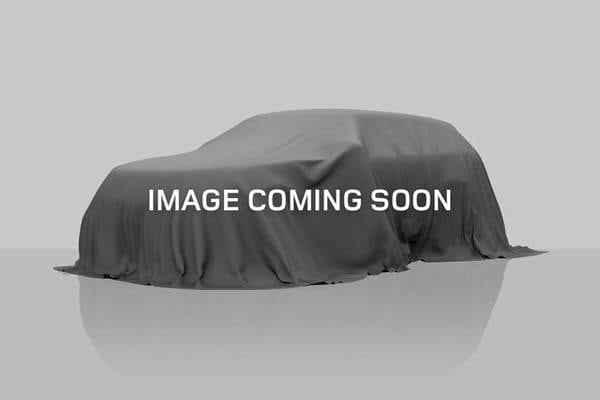2021 Aston Martin DBX Review
Price Estimate: $69,577 - $83,624
 View 207 more photos
View 207 more photos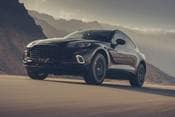 View 207 more photos
View 207 more photos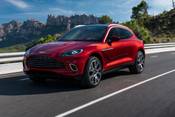 View 207 more photos
View 207 more photos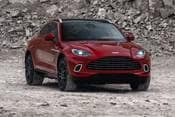 View 207 more photos
View 207 more photos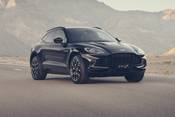 View 207 more photos
View 207 more photos+203
Average
7.6
out of 10
edmunds TESTED
We never thought we'd live to see an SUV by Aston Martin and yet here we are. The 2021 DBX blends Aston Martin's distinctive styling with a spacious cabin, a decent amount of utility, and a powerful V8 engine. But in a growing field of super SUVs, the DBX doesn't break any new ground in performance, function or technology. In other words, you'll have to really want an Aston Martin SUV to justify paying for one.
Oops, we can’t seem to locate you.
Please enter U.S. ZIP code to see vehicles for sale
2021 Aston Martin DBX Review
Pros
- Gutsy 542-hp engine
- Sharp steering and handling
- Plenty of standard interior luxuries
Cons
- Infotainment system can be distracting to use
- Uncomfortable ride on rutted roads
- Operation of advanced driver aids lacks refinement
What's new
- First SUV from Aston Martin
- Standard turbocharged V8
- Seating for five
- Kicks off the first DBX generation for 2021
Overview
Porsche long ago proved that performance and SUVs need not be mutually exclusive. Now it's Aston Martin's turn to show how it can be done. The 2021 Aston Martin DBX is the automaker's first-ever SUV, and one of just a few exotic-branded SUVs on the market. As a midsize five-seat SUV priced above $175,000, it's a rival to the likes of the Lamborghini Urus and Bentley Bentayga.
For sale nearby
56 listings
- $79,995fair price$547 below market
- 43,471 miles
- 1 accident, 2 owners, personal use
- 5 Seats, 14 City / 18 Hwy MPG
- Ineos Grenadier Of Lake Bluff (544 mi away)
- AWD/4WD
- Bluetooth
- Navigation
- Leather Seats
- Sunroof/Moonroof
Close
Located in Lake Bluff, IL
2021 Aston Martin DBX Base 4D Sport Utility Xenon Gray 4.0L V8 9-Speed Automatic AWD14/18 City/Highway MPG14 Speakers, 4-Wheel Disc Brakes, ABS brakes...
AutoCheck Vehicle History Summary
Accident Free Vehicle: No
Personal Use Only: Yes
History Provider: AutoCheck
Title Details: Clean Title
Salvage Vehicle: No
Frame Damage: No
Theft History: No
Lemon Status: No
Free History Report: No
Features and Specs:
15 Combined MPG (14 City/18 Highway)
Listing Information:
VIN: SCFVUJAW8MTV01968
Stock: II0006A
Certified Pre-Owned: No
Listed since: 08-28-2025 - $96,800fair price$3,161 below market
- 19,933 miles
- No accidents, 1 owner, personal use
- 5 Seats, 14 City / 18 Hwy MPG
- Napleton's Aston Martin of Chicago (556 mi away)
- AWD/4WD
- Bluetooth
- Navigation
- Leather Seats
- Sunroof/Moonroof
Close
Located in Downers Grove, IL
Aston Martin DBX special ordered in Zaffre Blue paintwork - a stunning color available exclusively through the Q-personalization division. The interio...
AutoCheck Vehicle History Summary
Accident Free Vehicle: Yes
Personal Use Only: Yes
History Provider: AutoCheck
Title Details: Clean Title
Salvage Vehicle: No
Frame Damage: No
Theft History: No
Lemon Status: No
Free History Report: No
Features and Specs:
15 Combined MPG (14 City/18 Highway)
Listing Information:
VIN: SCFVUJAW9MTV04054
Stock: PPG5342
Certified Pre-Owned: Yes
Listed since: 05-27-2025
As you'd expect from Aston, performance is a key attribute. Power comes from an updated version of the Mercedes-sourced turbocharged V8 that's in the Vantage and DB11 sports cars. The engine produces 542 horsepower and 516 lb-ft of torque. Mat the gas pedal and the resulting acceleration is explosive. The DBX loves to pull away quickly from a stop; you'll have to be judicious with the accelerator if you want to build speed without pinning your passengers to their seatbacks.
All the right materials are present inside the DBX, with wood, metal, leather and available faux suede trim throughout the cabin. As is typical of ultra-luxury cars, the DBX is pretty much loaded with features out of the gate. A configurable 12.3-inch digital instrument panel sits behind the steering wheel, though the true focal point is the 10-inch display screen in the center stack. As with the engine, the infotainment system is sourced from Mercedes. Unfortunately, it's an older design and is not as easy to use as Mercedes' more modern MBUX system.
On the whole, however, Aston Martin has done right with its first SUV. With effortlessly quick acceleration, stupefying handling and a top-notch interior, the DBX earns its place among the most impressive exotic SUVs on the market.
Edmunds Expert Rating
edmunds TESTED
by the Edmunds Experts
Average
7.6
out of 10
We drove the 2021 Aston Martin DBX on our test track and on real roads. Our Edmunds team conducts rigorous independent vehicle testing, driving 500,000 miles a year.
Performance
8/10
How does the DBX drive? Aston Martins have never been about world-dominating speed and grip, and the DBX isn't looking to change that. Instead you'll find an appreciable balance of everything that makes for a suitable grand-touring vehicle.
With its turbocharged 4.0-liter V8 thrumming under the hood, our DBX test vehicle sprinted from 0 to 60 mph in 4.4 seconds and cleared the quarter-mile in 12.5 seconds at 112 mph. That's ample speed for a performance SUV. The DBX also has a quick-shifting gearbox, communicative steering, and strong and smooth braking performance. Our only real complaints pertain to a slightly unrefined engine stop-start system and mildly overbearing stability control.
With its turbocharged 4.0-liter V8 thrumming under the hood, our DBX test vehicle sprinted from 0 to 60 mph in 4.4 seconds and cleared the quarter-mile in 12.5 seconds at 112 mph. That's ample speed for a performance SUV. The DBX also has a quick-shifting gearbox, communicative steering, and strong and smooth braking performance. Our only real complaints pertain to a slightly unrefined engine stop-start system and mildly overbearing stability control.
Comfort
8/10
How comfortable is the DBX? The DBX is comfortable but falls short in a few areas. The front seats in particular feel a little flat and unyielding. They have excellent lateral support to hold you in place while cornering, but they lack any extending support for the lower cushion. The standard adaptive air suspension delivers a commendable ride over nearly any surface, especially considering the large 22-inch wheels that the DBX rolls on. Road noise is also pretty minimal, though wind noise is somewhat more prevalent.
The DBX has tri-zone climate (some competitors offer four-zone systems) and the system is able to warm or cool the cabin quickly. The heated and ventilated seats also work quickly. But we don't like the way the climate controls are laid out. Some functions are toggles or capacitive buttons, while other functions are accessed through the digital display.
The DBX has tri-zone climate (some competitors offer four-zone systems) and the system is able to warm or cool the cabin quickly. The heated and ventilated seats also work quickly. But we don't like the way the climate controls are laid out. Some functions are toggles or capacitive buttons, while other functions are accessed through the digital display.
Interior
7.5/10
How’s the interior? Aston Martin has put some of the most beautiful sports cars on the road. But with the DBX, some of the eye-catching design comes at the expense of function. Door handles, window controls and seat controls all look great but present ergonomic challenges. Our biggest gripe concerns the infotainment system: The central display lacks touchscreen functionality. Seriously, why?
The rest of the DBX interior is quite good. The cabin is spacious, especially in the back seat. There's a generous amount of legroom and enough headroom to accommodate someone as tall as 6-foot-5. Despite the unintuitive seat controls, we eventually found a comfortable driving position as well. Visibility out of the cockpit is good, especially to the front.
The rest of the DBX interior is quite good. The cabin is spacious, especially in the back seat. There's a generous amount of legroom and enough headroom to accommodate someone as tall as 6-foot-5. Despite the unintuitive seat controls, we eventually found a comfortable driving position as well. Visibility out of the cockpit is good, especially to the front.
Technology
7/10
How’s the tech? Technology is where the DBX indisputably trails the pack. First, the good: 1) the 14-speaker audio system, which doesn't carry the markings of any notable audio brand, produces crisp and clear sound quality and 2) the voice recognition system can recognize most commands using natural speech.
It's mostly downhill from there. Everything from using the navigation system to changing the climate controls is a small chore. The infotainment system is supposed to have Apple CarPlay smartphone integration, but we were unable to get it to work during our DBX test. There are four USB ports for charging devices but no wireless charger, which we think is an oversight at this price.
Though the DBX had most of the modern advanced driving aids, their functionality left much to be desired. Adaptive cruise stopped abruptly on a few occasions and the lane keeping system seemed far too sensitive in detecting lane markings yet was useless for actually staying in the lane.
It's mostly downhill from there. Everything from using the navigation system to changing the climate controls is a small chore. The infotainment system is supposed to have Apple CarPlay smartphone integration, but we were unable to get it to work during our DBX test. There are four USB ports for charging devices but no wireless charger, which we think is an oversight at this price.
Though the DBX had most of the modern advanced driving aids, their functionality left much to be desired. Adaptive cruise stopped abruptly on a few occasions and the lane keeping system seemed far too sensitive in detecting lane markings yet was useless for actually staying in the lane.
Storage
7.5/10
How’s the storage? Cargo and storage will always be a relevant topic for any SUV, no matter how exotic. The DBX offers a fairly good amount of utility with a rear cargo area of just over 22 cubic feet, and all of it is pretty usable. The rear seats split in three sections and fold virtually flat for when you need to carry longer items.
Inside there are various places, all modestly sized, for storing personal items. A leather-lined bonus area beneath the center console looks to be a perfect spot for a wireless charger, but we didn't find one there. Most luxury SUVs don't do a great job of offering ample interior storage, so the DBX is not an outlier. Should you want to use your exotic SUV as a school bus, you'll be pleased to know that the child safety seat anchors are easily accessible, and there's a helpful amount of space for installing even a bulky rear-facing model.
Inside there are various places, all modestly sized, for storing personal items. A leather-lined bonus area beneath the center console looks to be a perfect spot for a wireless charger, but we didn't find one there. Most luxury SUVs don't do a great job of offering ample interior storage, so the DBX is not an outlier. Should you want to use your exotic SUV as a school bus, you'll be pleased to know that the child safety seat anchors are easily accessible, and there's a helpful amount of space for installing even a bulky rear-facing model.
Fuel Economy
6.5/10
How’s the fuel economy? This is not the SUV to buy if you're concerned with efficiency, but that said, it's not the worst of the bunch either. The DBX carries an official rating of 15 mpg combined (14 city/18 highway), which aligns with vehicles such as the BMW X5 M and Bentley Bentayga. But let's be real, no one will be making this point. For what it's worth, the DBX returned slightly better fuel economy than expected on Edmunds' 115-mile evaluation route, averaging 19.7 mpg.
Value
6.5/10
Is the DBX a good value? While you can't really place a value on exclusivity, we can compare what a vehicle objectively offers versus its competition. The quality of materials in the DBX is exquisite, and we can't remember any vehicle with more leather-wrapped surfaces. There is a lot of super-soft leather here.
For better and for worse, Astons also have a hand-built quality and feel to them. Some gaps and seams, though, aren't quite lined up tightly, and while some may find this charming, others might find it frustrating at this price point. But objectively speaking, the DBX offers nothing that its less expensive peers provide other than the Aston Martin badge. For some, the brand alone is a compelling enough argument.
The DBX offers similar warranty coverage to other brands of this ilk, with three years of comprehensive warranty coverage and roadside assistance and a 10-year corrosion warranty, all without mileage limits.
For better and for worse, Astons also have a hand-built quality and feel to them. Some gaps and seams, though, aren't quite lined up tightly, and while some may find this charming, others might find it frustrating at this price point. But objectively speaking, the DBX offers nothing that its less expensive peers provide other than the Aston Martin badge. For some, the brand alone is a compelling enough argument.
The DBX offers similar warranty coverage to other brands of this ilk, with three years of comprehensive warranty coverage and roadside assistance and a 10-year corrosion warranty, all without mileage limits.
Wildcard
8.5/10
The DBX is middle of the pack when it comes to fun behind the wheel. Most other exotic SUVs are quicker and have more grip, but the DBX offers a more artisanal balance of things. Those expecting world-beating performance will be left wanting more, but if you're familiar with the Aston Martin experience, the DBX will feel just right.
And when it comes to design, we think Aston Martin nailed the look of the DBX. The brand's design DNA translates surprisingly well, with muscular lines that also manage to look graceful. It looks like an Aston Martin but also like nothing else on the road.
And when it comes to design, we think Aston Martin nailed the look of the DBX. The brand's design DNA translates surprisingly well, with muscular lines that also manage to look graceful. It looks like an Aston Martin but also like nothing else on the road.
2021 Aston Martin DBX trim level differences
The Aston Martin DBX doesn't have any trim levels; instead it offers a multitude of stand-alone options as well as traditional and lifestyle-based option packages. If the seemingly endless list of options and interior combinations is overwhelming, Aston Martin offers ready-made, curated builds, even down to the paint color. All DBXs have a turbocharged 4.0-liter turbocharged V8 engine (542 horsepower, 516 lb-ft) and a nine-speed automatic transmission to route power to all four wheels.
Which DBX trim does Edmunds recommend?
With its impressive list of standard equipment and high-quality leather interior, any DBX would be fine with us. But if we were picky, we'd opt for one (or all) of the carbon-fiber exterior appearance packages as well as a custom two-tone leather interior and the sport exhaust. Hey, we can dream.
Compare 2021 Aston Martin DBX trim levels
Helpful trims summary and side-by-side comparison chart
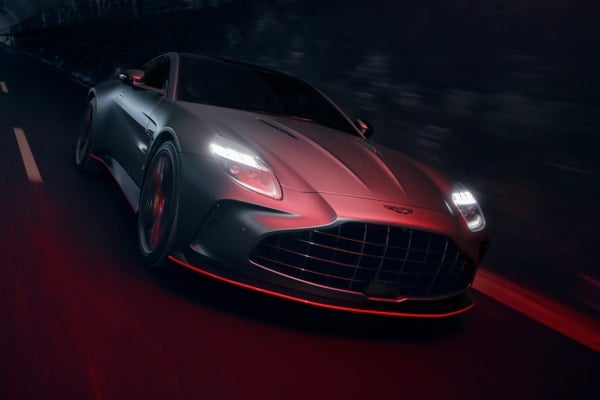
2026 Aston Martin Vantage S First Look: More of Everything, Everywhere

Apple CarPlay Ultra Is a Whole New Way to Use Your Car
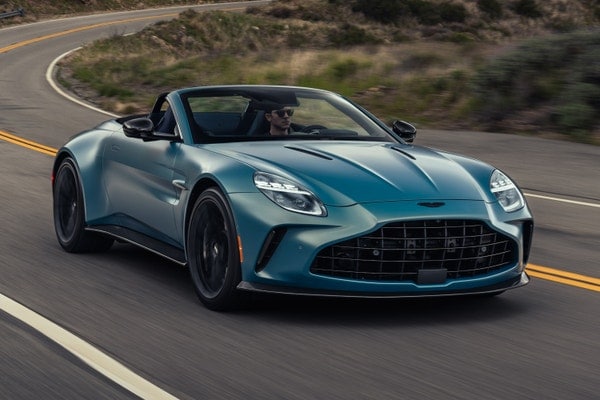
2026 Aston Martin Vantage Roadster First Drive: So Much Better Than Before
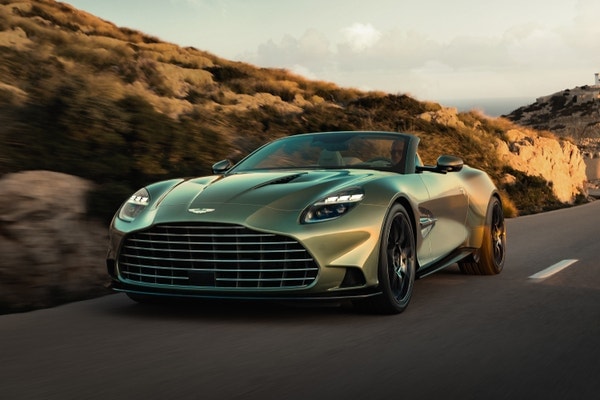
2026 Aston Martin Vanquish Volante First Look: The Flagship Goes Open-Top
Cost to Drive
Monthly estimates based on costs in North Dakota
$315/mo for DBX Base
DBX Base
vs
$232/mo
Avg. Large SUV
Reliability
The 2021 Aston Martin DBX has a 3 years / unlimited miles basic warranty and 3 recalls. Below you’ll find our owner reviews.
Recalls
3 recalls foundChecking if a car has a recall is simple. Just type the car's VIN number into the NHTSA website (https://www.nhtsa.gov/recalls). If there's an unrepaired recall, you'll see it there.
If a recall shows up, just call your local car dealer. They'll know about the recall and will work with the car maker to fix it for free (if the recall happened within 10 years of the car being first sold).
- Recall Number:
- 24V255000
- Manufacturer Recall Number:
- RA-63-1832
- Number of vehicles affected:
- 2902
- Defect Description:
- Aston Martin The Americas (Aston Martin) is recalling certain 2021-2024 DBX vehicles. Electrical cables in the battery fuse box may be loose, which can result in an engine stall, or a loss of headlights and/or power steering.
- Defect Consequence:
- An engine stall or loss of headlights and/or power steering can increase the risk of a crash.
- Corrective Action:
- Dealers will inspect the fuses and cables for damage and replace them as necessary. In addition, the fasteners will be replaced. Repairs will be performed free of charge. Owner notification letters were mailed June 2, 2024. Owners may contact Aston Martin customer service at 1-888-923-9988. Aston Martin's number for this recall is RA-63-1832.
- Recall Number:
- 24V248000
- Manufacturer Recall Number:
- RA-51-1928
- Number of vehicles affected:
- 10
- Defect Description:
- Aston Martin The Americas (Aston Martin) is recalling certain 2021 DBX vehicles. The fasteners for the front propeller shaft and front differential may be loose, which can result in a loss of front wheel drive or an engine stall.
- Defect Consequence:
- A loss of front wheel drive or an engine stall can increase the risk of a crash.
- Corrective Action:
- Dealers will inspect the fasteners, and tighten them if necessary, free of charge. Owner notification letters were mailed July 16, 2024. Owners may contact Aston Martin customer service at 1-888-923-9988. Aston Martin's number for this recall is RA-51-1928.
- Recall Number:
- 20V784000
- Manufacturer Recall Number:
- RA-30-1471
- Number of vehicles affected:
- 151
- Defect Description:
- Aston Martin The Americas (Aston Martin) is recalling certain 2021 DBX vehicles. The vehicles were incorrectly built without headliner foam blocks. As such, these vehicles fail to comply with the requirements of Federal Motor Vehicle Safety Standard (FMVSS) number 201, "Occupant Protection in Interior Impact."
- Defect Consequence:
- The missing foam blocks can increase the risk of injury to unbelted occupants in the event of a crash.
- Corrective Action:
- Aston Martin will notify owners, and dealers will install the headliner foam blocks, free of charge. The recall is expected to begin January 31, 2021. Owners may contact Aston Martin customer service at 1-888-923-9988. Aston Martin's number for this recall is RA-30-1471.
Warranty
3 years / unlimited miles Basic Warranty- Basic Warranty
- 3 years / unlimited miles
- Drivetrain Warranty
- 3 years / unlimited miles
- Rust Warranty
- 10 years / unlimited miles
- Roadside assistance Warranty
- 3 years / unlimited miles
Aston Martin DBX Owner Reviews
Most Helpful Owner Reviews
Trending topics
Multiple Suspension Failures
1 out of 5 starsK Naidu , 11/21/2021
2021 Aston Martin DBX 4dr SUV AWD (4.0L 8cyl Turbo 9A)
We own a DBX in Dallas, Texas. Our dealership has been great trying to help us resolve the software issues with Aston. However, the problems are still unresolved and unfortunately the new software patch raised the suspension significantly and the car drives like an out of control truck. I’d wait a couple years to buy this car and give Aston time to fix the software issues.
Best SUV on market...Period!
5 out of 5 starsS.Hons, 03/16/2021
2021 Aston Martin DBX 4dr SUV AWD (4.0L 8cyl Turbo 9A)
Overall - 9/10
I had mixed emotions when I saw it for the first time. Once I drove it, I realized what makes an Aston Martin an Aston Martin. It’s the drive and prestige. The DBX exceed my high expectations on all levels - as I was considering the Urus, Bentagya, and Tycan S-Turbo in my search.
Positives - Stylish, Handling, Acceleration, Power/Performance, Appearance
Negs - … Non-electric, Electronics/Car (Dated), 1st Generation Vehicle
Nonetheless, I purchased it and cannot tell you how happy I am with the DBX. I would skip doing the drives....Go straight to Aston Martin and purchase it. I am a car enthusiast and own many cars...I can tell you an Aston Martin is real thing....and SUV even more so.
Great job Aston Martin....I wish you the best with SUV.
Worth the test drive!
5 out of 5 starsDevan Vincent, 10/07/2020
2021 Aston Martin DBX 4dr SUV AWD (4.0L 8cyl Turbo 9A)
Recently I went to an Aston Martin dealership and test drove the DBX because it has interested me and it is supposedly the car that will save the brand. It was a simple 10/10 after driving it. Its performance was excellent. Technology was an upgrade. Comfort was top notch. Safety is a plus. Reliability is good because it’s an SUV. Also the value was just right. I’m thinking of selling my … GTC4Lusso and probably get this.
2021 Aston Martin DBX video
Lamborghini Urus vs. Aston Martin DBX | Exotic SUV Showdown & Drag Race
The Aston Martin DBX and Lamborghini Urus are among the quickest and most opulent SUVs money can buy. These are super SUVs with the power and luxury to match, which means our expectations are in the stratosphere.
2021 DBX Highlights
| Base MSRP Excludes Destination Fee | $176,900 |
|---|---|
| Engine Type | Gas |
| Combined MPG | 15 MPG |
| Cost to Drive | $315/month |
| Seating | 5 seats |
| Cargo Capacity All Seats In Place | 22.3 cu.ft. |
| Drivetrain | all wheel drive |
| Warranty | 3 years / unlimited miles |
Safety
Our experts like the DBX models:
- Automatic emergency braking
- Warns if a front impact is imminent and applies the brakes if you don't respond in time.
- Blind-spot monitor
- Alerts you if a vehicle in the next lane over is in your blind spot.
- Lane keeping assist
- Steers the DBX back into its lane if it begins to drift over the lane marker.
People who viewed this also viewed
| Starting at $77,900 |
Related Used 2021 Aston Martin DBX info
Vehicle reviews of used models
- BMW X6 M 2021 Review
- Honda Passport 2020 Review
- Mclaren 720S Spider 2020 Review
- Nissan Pathfinder 2020 Review
- Mercedes Benz A Class 2021 Review
- Chevrolet Colorado 2021 Review
- Aston Martin Vantage 2020 Review
Shop used vehicles in your area
Popular new car reviews and ratings
Research other models of Aston Martin
Research similar vehicles
Other models
- New Chevrolet Colorado for Sale in Middletown, NY
- Used BMW XM in Duluth, MN 2025
- Used Mazda 5 in Marina Del Rey, CA 2015
- Used Nissan Quest in Colton, CA 2017
- Used BMW Ix in Benton Harbor, MI 2026
- New Hyundai Elantra-N for Sale in Muncie, IN
- Used Toyota Gr-Corolla in Goshen, IN 2025
- Used Ford Transit-Cargo-Van in Aberdeen, MD 2026
- Used Mercedes-Benz Gle-Class in Sikeston, MO 2025
- Used Toyota T100 in Danville, CA 1998
